Slate Mines
Slate is a collective term for rocks that have excellent cleavage along closely spaced parallel surfaces, so-called schistosity surfaces. This primarily concerns rocks that have emerged from sedimentary rocks through metamorphism or tectonic forces. There are also sedimentary rocks that are very fissile along their primary bedding planes even without metamorphism and are called slate. In modern petrography, however, slate is only used for tectonically stressed or metamorphic rocks.
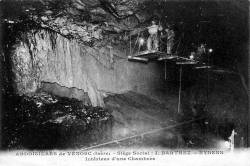

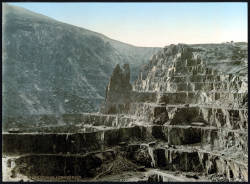
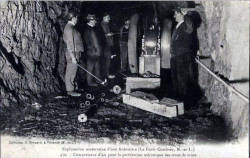
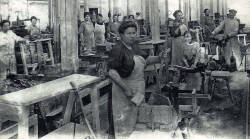
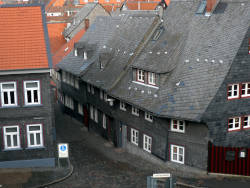
On showcaves.com we refer to slate that was extracted in mines. A scientific definition of the term is much less interesting than the economical use of the rock.
Slate is primarily used for roofs. To do this, it must be able to be split so thinly that the weight can be borne by the roof. It must also be waterproof. And finally, it should last for many decades without weathering. In other words, slate has no pore space and is therefore both waterproof and resistant to frost heave.
Other uses for slate are wall panels, so-called façade slate, for which essentially the same applies. Recently, slate has been increasingly used as floor tiles, table tops, window sills, kitchen worktops and settings for stoves and fireplaces. Industrially, it has been used as a wall material for acid-proof tanks. Billiard tables are also usually made of slate. There is also its use as slate boards for writing, but these have nowadays been completely replaced by coated wooden boards.
Mining
Slate has been extracted from mines since Roman times. The reason for this is simple: if the slate is on the surface for a long time and is exposed to the weather, it weathers. Then it is no longer waterproof and also no longer durable. If it is mined in quarries, the upper metres have to be removed to reach the unweathered slate. Nevertheless, even exposed blocks weather quite quickly and can no longer be split well after a short time. Slate quarries are more or less only found in Britain, where winters are usually frost-free and weathering is therefore low.
Slate is quarried in large blocks, depending on the geological conditions. In the past, this was done with picks, with hammer and chisel, and with riving knives. In some cases, special, very weak explosive charges were also used. These blocks were broken down into transportable sizes with wedges and impact hammers. Transport to the surface was done by mine train cart and mine elevator, as is common in mines.
Mining in the 21st century is done using modern equipment and machinery. The blocks are raster-sawed in the mine with a diamond saw, and the blocks are loaded onto wheel loaders. Onward transport is still done by mine train and mine elevator. But there are also alternatives. The Margareta mine had driven a ramp in the shape of a spiral down to the mine, which allowed two-way traffic. In this way, the stones were transported from the quarry to the processing plant by large trucks without reloading. The empty trucks return to the mine via the same ramp.
Processing
The actual processing takes place above ground. Slate mines therefore have a very high proportion of personnel above ground. Here, the slates are first split so that they have a thickness of about 5 mm, which is ideal for roofing slabs. Then they are hewn or cut into the desired shape. Cutting is done with special scissor-like machines where one cutting blade is fixed, and one is moved with a long lever. For roof shingles, they are usually made square with rounded corners and a hole in one corner. Through this hole they can be fastened to the roof truss with a nail. The roof is covered by overlapping the sheets.
For the final finishing of roof slates, manual labour is still required. The prepared blocks are brought to their final shape on a piecework basis. This high level of manual labour is probably one of the main reasons why slate mines in Germany, which were market leaders only ten years ago, have now closed down. However, the depletion of deposits is also partly responsible.
Show Mines
The use of roofing slate seems to have a long tradition in certain parts of Germany, Luxembourg, Belgium, and France, as well as in Great Britain. Of course, it was mainly used where it could be quarried. The best slate is probably found in the Eifel and Ardennes, although the Australian Mintaro Slate claims to be the best slate in the world.
With the industrial revolution, however, there were also transport possibilities, especially with the railway. And so slate was used in areas where it was not mined, and areas with slate deposits could mine for export. In many cases this led to greater sales and better profitability, but it could also lead to cheaper competition.
In the 20th century, there was a clear trend towards fewer and fewer, larger and larger producers. The large number of small-scale mines operated by craftsmen was not competitive. At the end of the 20th century, there were only a few slate mines in Central Europe that were more or less market leaders.
However, due to the high costs of the necessary manual labour, slate mining was again relocated, mainly to Spain. The use of slate is probably greatest in France, followed by Benelux and Germany, as well as Great Britain. Today, however, the slate mostly comes from Spain, which hardly uses any slate itself and only mines it for export to Central Europe. Often, however, the mines there are operated by the mining companies that have given up their own mining in Central Europe.
A very significant effect of this development is also that in the meantime a great many slate mines have been converted into show mines. There are now two "slate routes", tourist routes that can be travelled by car, along which several slate mines are located. In France and the Benelux countries this is the Route de l’Ardoise (Slate Route), in the Eifel the Moselschiefer-Straße (Mosel Slate Road), and in eastern Germany the Thüringisch-Fränkische Schieferstraße (Thuringian-Franconian Slate Route). We have pages for two, the Moselschiefer-Straße concentrates on uses of slate and does not include any mine, so we recommend the respective Wikipedia page.
- Examples
 Mintaro Slate Quarries, Australia
Mintaro Slate Quarries, Australia Ardois’alle, Belgium
Ardois’alle, Belgium Bertrix Slate Mine, Belgium
Bertrix Slate Mine, Belgium Schieferstollen Recht, Belgium
Schieferstollen Recht, Belgium Schieferbergwerk im Engi, Switzerland
Schieferbergwerk im Engi, Switzerland Flascharův důl, Czech Republic
Flascharův důl, Czech Republic Břidlicové podzemí Raabova štola, Czech Republic
Břidlicové podzemí Raabova štola, Czech Republic Historisches Dachschieferbergwerk Assberg, Germany
Historisches Dachschieferbergwerk Assberg, Germany Schieferbergwerk Grube Christine, Germany
Schieferbergwerk Grube Christine, Germany Felicitas Heilstollen, Germany
Felicitas Heilstollen, Germany Besucherbergwerk Fell, Germany
Besucherbergwerk Fell, Germany Schiefergrube Herrenberg, Germany
Schiefergrube Herrenberg, Germany Schieferpark Lehesten, Germany
Schieferpark Lehesten, Germany Schieferschaubergwerk Raumland, Germany
Schieferschaubergwerk Raumland, Germany La Mine Bleue, France
La Mine Bleue, France Musée de l’ardoise de Fumay, France
Musée de l’ardoise de Fumay, France Musée de l’Ardoise et de la Géologie, France
Musée de l’Ardoise et de la Géologie, France Maison de l’ardoise de Rimogne, France
Maison de l’ardoise de Rimogne, France Souterroscope des Ardoisières, France
Souterroscope des Ardoisières, France Musée de l’Ardoise à Trélazé, France
Musée de l’Ardoise à Trélazé, France Carnglaze Slate Caverns, Great Britain
Carnglaze Slate Caverns, Great Britain Corris Mine Explorers, Great Britain
Corris Mine Explorers, Great Britain Go Below Underground Adventures, Great Britain
Go Below Underground Adventures, Great Britain Hodge Close, Great Britain
Hodge Close, Great Britain Honister Slate Mine, Great Britain
Honister Slate Mine, Great Britain King Arthur’s Labyrinth, Great Britain
King Arthur’s Labyrinth, Great Britain The Welsh Slate Museum, Great Britain
The Welsh Slate Museum, Great Britain Chwarel Hên Llanfair, Great Britain
Chwarel Hên Llanfair, Great Britain Llechwedd Slate Cavern, Great Britain
Llechwedd Slate Cavern, Great Britain Millican Daltons Cave, Great Britain
Millican Daltons Cave, Great Britain Rydal Cave, Great Britain
Rydal Cave, Great Britain Ardoisière Haut-Martelange, Luxembourg
Ardoisière Haut-Martelange, Luxembourg Pæska Skiferbrudd, Norway
Pæska Skiferbrudd, Norway Miniexpozíca Ťažby a Spracovania Bridlice v Marianke, Slovakia
Miniexpozíca Ťažby a Spracovania Bridlice v Marianke, Slovakia Route de l’Ardoise
Route de l’Ardoise Thüringisch-Fränkische Schieferstraße
Thüringisch-Fränkische Schieferstraße
 Search DuckDuckGo for "slate"
Search DuckDuckGo for "slate" Slate - Wikipedia (visited: 31-OCT-2023)
Slate - Wikipedia (visited: 31-OCT-2023) Roofing Slate Dictionary (visited: 31-OCT-2023)
Roofing Slate Dictionary (visited: 31-OCT-2023)
 Index
Index Hierarchical
Hierarchical Countries
Countries Maps
Maps